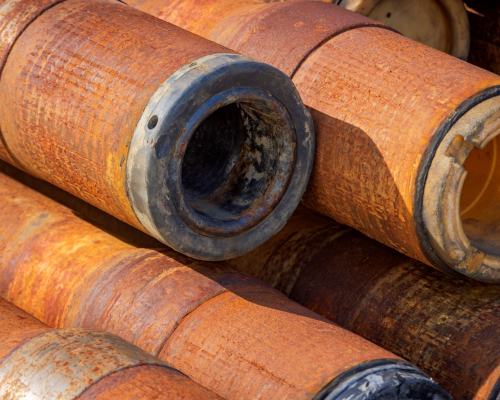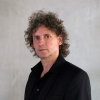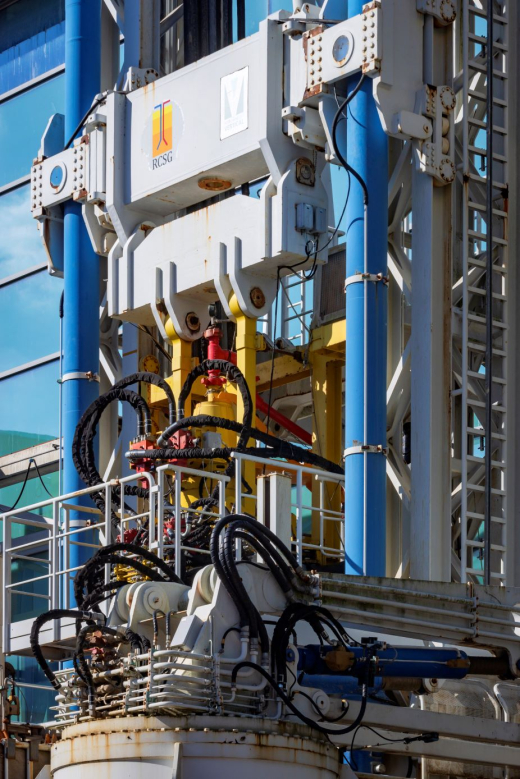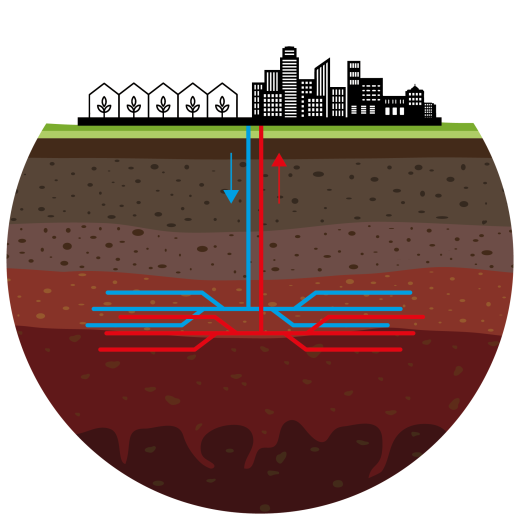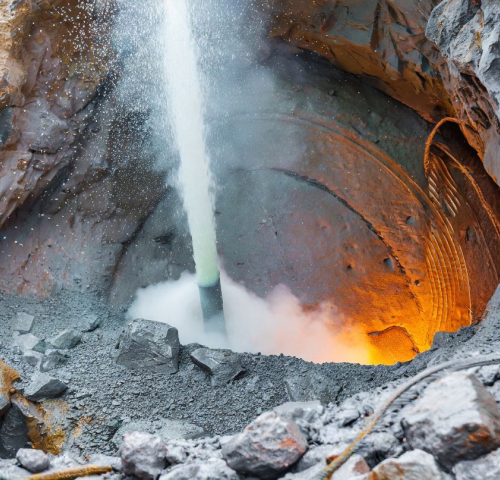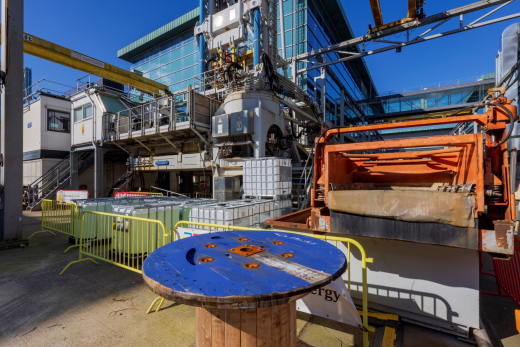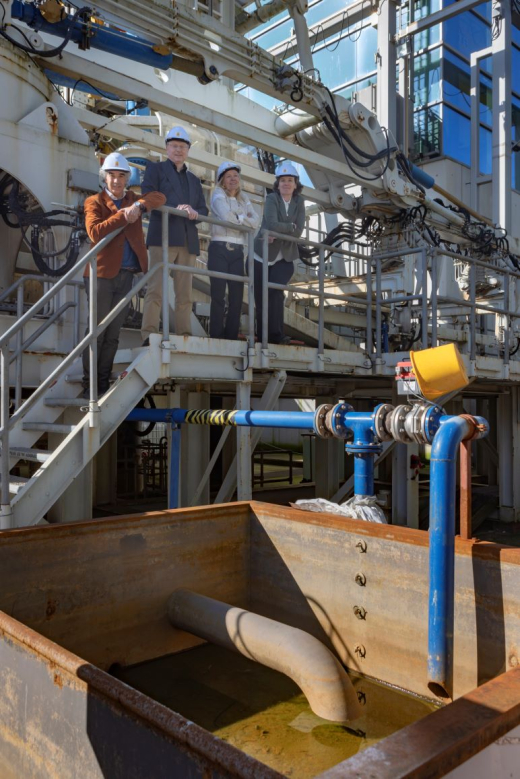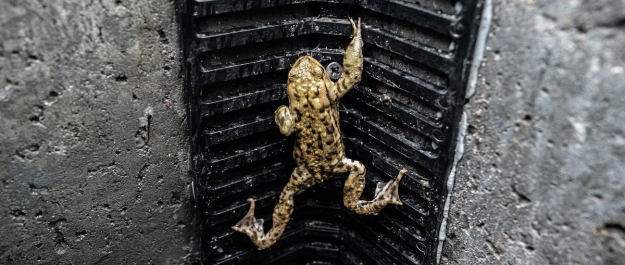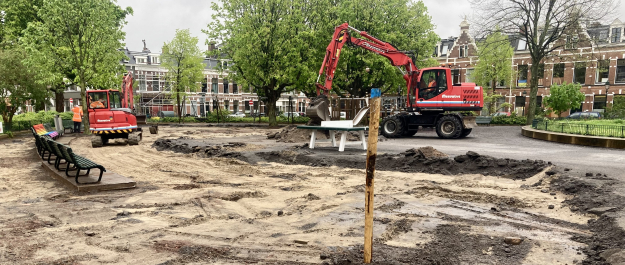Geothermal energy could become a major contributor to the worldwide transition to sustainable heat and electricity. However, the construction cost of geothermal installations is often too high to be economically viable. That is why the Global Geothermal Impact Summit 2024 (GGIS2024) in The Hague is all about making geothermal developments financially attractive. The Hague start-up Canopus leads by example by developing a low cost geothermal drilling technology and finding the required financing. Their drilling technique can create long and branched bore hole structures that produce 2.5 times more energy per installation.
Canopus’ patented technology can do something that others cannot: drill horizontally or with a curve and also ultra-deep up to 4,000 meters depth. The technique also allows the drilling of so-called open hole side-tracks which enables the drilling of branched structure, similar to tree-root structures. The new drilling method is called Directional Steel Shot Drilling (DSSD). It uses high pressure jets containing steel shot particles, which are being retrieved at surface after they have been supporting the hole making of a conventional bit downhole. By shooting extra steel particles through the drill bit nozzles in the desired drilling direction the hole making can make turns and the drilling assembly can be navigated towards a target location.
Solution for heat crisis and grid congestion
Around 50% of the world’s energy is currently used to heat homes and buildings. Due to the increase in wind and solar energy, this is more and more done electrically, for example via heat pumps. But the electricity grid cannot cope with this increased supply and demand, leading to congestion.
“Geothermal is a great solution for both problems. The final challenge is that geothermal energy is often too expensive. Mainly due to the drilling costs.”
Ideal conditions
Geothermal energy is a sustainable alternative to coal or gas-fired power stations. The principle seems simple. You drill a well to deeper layers of the earth and at 2.5 kilometers you encounter water of approximately 85 degrees Celsius. If you pump it up you can use it for heating networks for houses, greenhouses or other buildings. After extracting the heat, the water is pumped through another well down, back into the reservoir it came from. That is already being done in and around The Hague, in the Westland horticultural area and elsewhere in the Dutch province of South Holland. The conditions there are ideal and drilling is relatively cheap.
Horizontal drilling
The Dutch soil, compared to other countries, is well mapped. In some places in the Netherlands, the conditions are less favourable, the water does not flow upwards as easily or there is not enough of it. “In some places, geothermal energy is less accessible. Then you need to be able to drill long, horizontal sections through the hot water containing rock layers. "We have the solution for that,” says Wawoe. Switzerland, for instance, also has that problem. If you drill there, insufficient hot water will emerge for a profitable geothermal project. If you drill horizontally, much more water in that layer becomes available. That is why Swiss cities such as Lausanne and Geneva are very interested in Canopus’ technology.
Image: De Schaapjesfabriek (©)
“They would like to access more geothermal energy by exploiting the cost effective DSSD technology. On sites where geothermal energy currently is less profitable or available, we can get 2.5 times as much production from a well at 20 percent additional cost.”
Steam for electricity
If you drill as deep as 4 to 8 kilometer, you will encounter water of 130 to at least 250 degrees. You can extract this to produce steam, which can drive turbines to generate electricity. In many places. traditional drilling technologies are too expensive at such great depths. In some places, the operator chooses to install an underground radiator type system that only uses the temperature of the soil to heat water circulated from surface through the radiator and back to surface. At surface the very hot, pressurized water is depressurized which turns it into steam. This goes with a huge expansion which can drive a turbine.
The ultradeep deep geothermal energy is rarely used outside some specific areas and in most cases, it is not yet profitable. An important reason being the high cost of drilling the deep radiator-shaped structures. The Canopus’ DSSD technology being fast and steered is perfect for drilling these structures.
“If you could do this anywhere in the world with the directional steel shot drilling technique, you could have a sustainable energy source that is available 24 hours a day. One that can help overcoming grid congestion due to peaks and troughs in wind or solar energy. It would be great if geothermal energy could become a source of electricity in addition to being a source of heat.”
Global growth
Globally, geothermal energy production is growing steadily according to the latest report from the International Renewable Energy Agency (IRENA) and the International Geothermal Association (IGA) shows. Heat generation grew on an average rate of 9 percent annually between 2015 and 2020 to 107 gigawatts thermal. Electricity generation grew at a more modest rate of 3.5 percent annually to 15.96 gigawatts electric. To fight climate change, geothermal energy can and should play an important role in the green energy transition, both organizations say. By generating both sustainable energy heat and electricity. However, geothermal projects last several decades while requiring high upfront capital expenditures. Uncertainties in the subsurface model are also a financial risk during the early phases of exploration. That is why financing is often difficult.
The Hague as epicentre
The Hague region is transforming into the global epicentre for geothermal energy, combining world-class energy research institutions, industry and financing. For instance with TNO’s Rijswijk Center for Sustainable Geo-energy (RCSG), a former Shell drilling research and test centre. It is an open innovation lab, where companies can test and demonstrate their new drilling techniques, materials and other innovations. The establishment of the International Geothermal Association (IGA) in 2021 was an important milestone. IGA represents the global geothermal industry to international organizations such as the United Nations, the World Bank, the International Renewable Energy Agency and the International Energy Agency.
Summit for financing geothermal
With industry partners the IGA sets standards, matures the technology agenda and nurtures entrepreneurs engaged in clean technology. This Hague organisation hosts geothermal conferences and summits all over the world. During the Global Geothermal Impact Summit 2024, on April 24 and 25 in the Fokker Terminal in The Hague, financing geothermal energy will be the main topic. That aspect is just as important as technological innovation. The summit is gathering experts from the geothermal sector, financial institutions, government agencies and impact investors to pave the way for this sustainable energy.
ImpactCity The Hague
Canopus is part ImpactCity! ImpactCity The Hague is the city for entrepreneurs who combine ‘doing good and doing business’. ImpactCity offers a wide range of opportunities and services to entrepreneurs and other impact makers with innovative solutions.
Search for investors
Canopus was founded in 2019 by Jan Jette Blangé, an expert in drilling technology who has already registered more than 30 patents. Wawoe, a mechanical engineer from TU Delft, left his job at Shell Solar in 2018 and became a Co-director. The start-up knows the search for investors like no other. At the beginning, the company received a loan from the government, so-called early phase financing. In 2022, Canopus received a capital injection from ENERGIIQ, the Energy Innovation Fund of South Holland, and sustainable venture capital fund SHIFT Invest. This was linked to a subsidy from the EU Geothermal Program. A total investment of 2.6 million euros. In the same year, InnovationQuarter guided the entrepreneurs with their subsidy application for Kansen in West, raising another 400,000 euros. “Our experience in this can also be relevant to others,” says Wawoe.
Another investment
Canopus announced on the GGIS that they have secured a follow-on investment of 3 million euro led by new investor Underground Ventures, and existing investors SHIFT and ENERGIIQ.
Test projects
Canopus is currently working on three concrete test projects: 1. Green Village in Delft. 2.In the east of the Netherlands and they are testing their technology at the Rijswijk Centre for Geothermal Energy from TNO. Last year, drilling took place at the Swiss test center near Hagerbach. Once those projects have been completed, the start-up expects to enter the market with its new DSSD technology in 2025. “For the longer term, we are looking at several projects worldwide. Once the technology has been proven, many parties would like to use the technology,” says Wawoe.
The Global Geothermal Impact Summit 2024
The Global Geothermal Impact Summit 2024 takes on a mission that is critical to our planet’s future: financing geothermal energy. The conversation about geothermal energy continues at the Fokker Terminal in The Hague on 23 and 24 April 2024. Want to join?
Geothermal project in The Hague
'Haagse Aardwarmte Leyweg' known as HAL, produces and delivers geothermal energy to a residential area in The Hague and works closely with the municipality of The Hague, Eneco and Uniper (formerly E.ON) in the planning and implementation of this project.
The Rijswijk Centre for Sustainable Geo-energy (RCSG)
The Rijswijk Centre for Sustainable Geo-energy (RCSG) is a unique open innovation lab for improving geo-energy technologies to accelerate the energy transition. There is a particular focus on geothermal energy, an increasingly important renewable energy source, and subsurface storage of heat, hydrogen and CO2. The facilities are available for full-scale testing and demonstration of new drilling techniques, flow, and materials under high pressure and temperature.
Apollo 14 - Home of Impact Makers
The municipality of The Hague rents workspace in Apollo 14 to entrepreneurs who contribute to “Doing good and doing business” through technological and social innovations. As the international city of Peace and Justice, The Hague is the hotspot for (international) startups and scale-ups that focus on global challenges, like peace, law, security, energy, health, food, water, participation or other global challenges. In Apollo 14 you can join forces with other impact makers by working on innovations in one cool and inspiring place.
